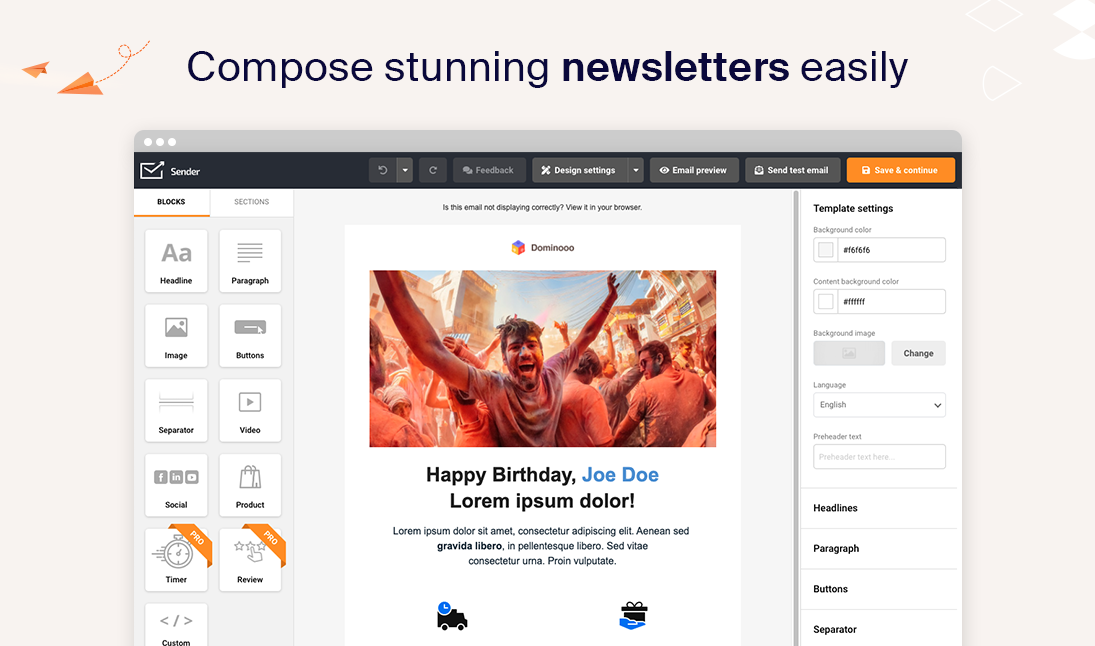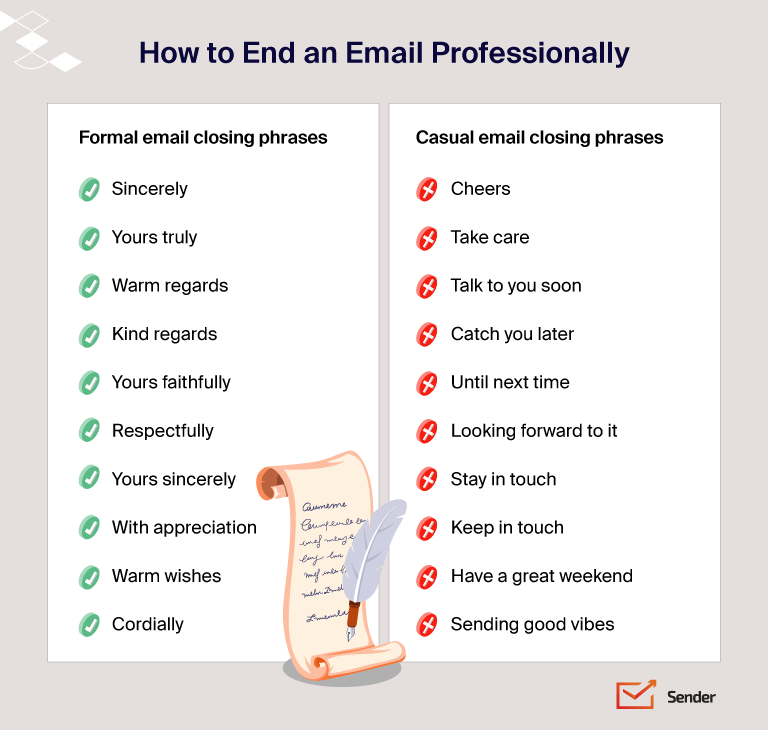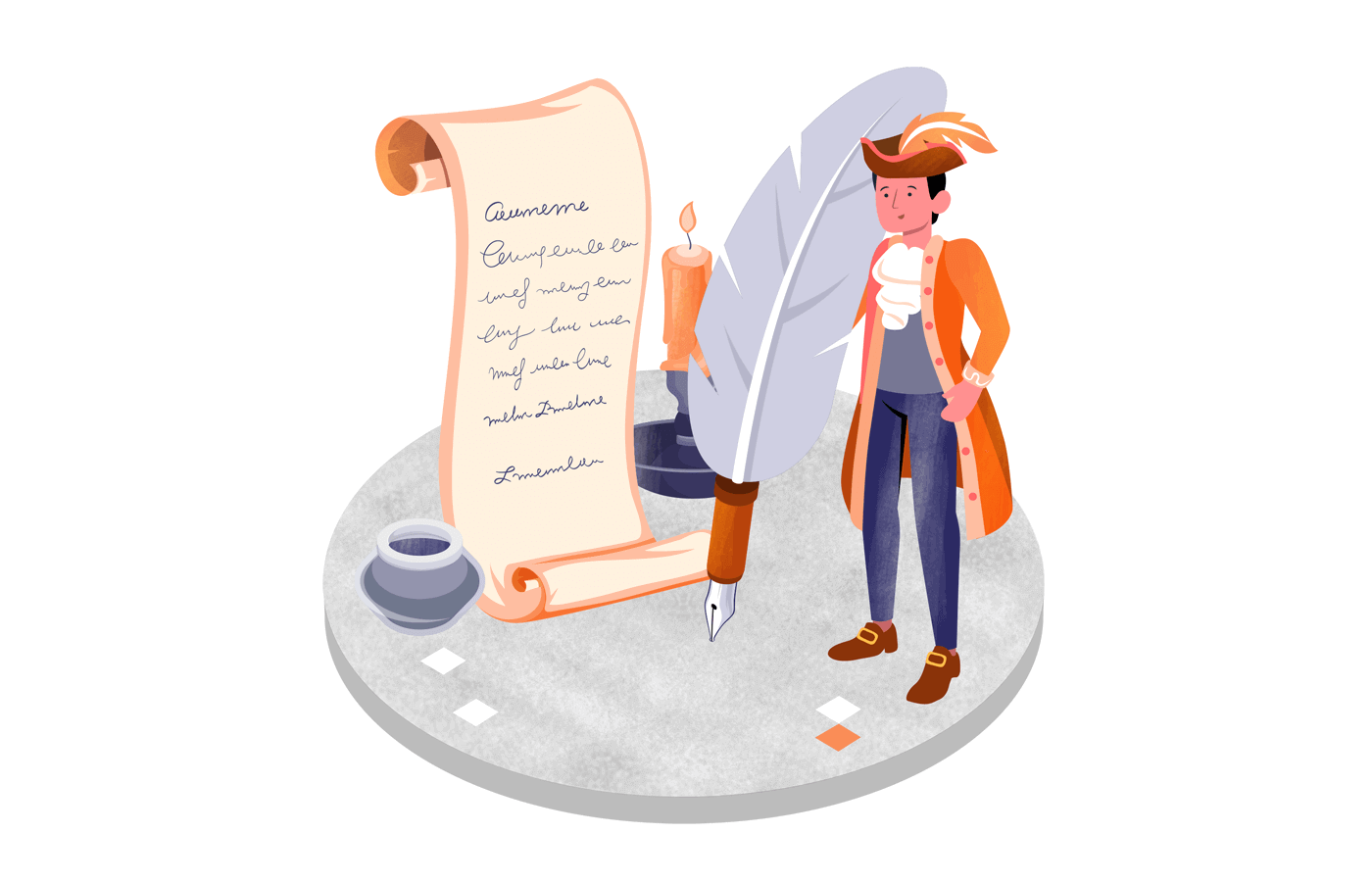With 4 million emails sent per second (361.6 bn/day), how many emails are good from the opening to closing?
As a considerable part of your daily tasks include professional correspondence online, you know well that creating such an email is easier said than done. Once you’ve put time and effort into crafting a subject line, intro, and body, the sign-off might feel rushed, and all that lingering finger wants to do is hit ‘send’.
Unfortunately, this is how the fly gets into the ointment. Ending the email professionally is crucial for writing clear and actionable emails and making a positive impression. Otherwise, you can expect the opposite result.
But don’t fret! Once you get a hold of our best practices below and use the given examples, bad email endings will become a thing of the past.
Introduction to Email Sign-Offs
An email sign-off, also called an email closing, is a phrase or few words you include at the end of your email message before your name and signature. Let’s take a closer look:
Importance of a Proper Email Closure
As in the case of any good book (or movie if you’re a screening advocate), the email closure is meant to conclude your message and leave a lasting impression on the recipient. What that impression will be depends on how you write it.
Here’s where you also call the recipients to a particular action, whether setting a meeting time, explaining a process, or answering your birthday party invitation. It’s crucial to be crystal clear on what you want them to do after reading your email.
First Impressions and Last Impressions in Digital Communication
When more and more people scream at incoming calls while others are ‘seen’ on chat messages, the good old email remains a trusty way to leave a wanted impression in this digital era.
But it’s not just the message that matters. While it’s true that the first sentence can make a first impression, whether your recipient closes the inbox with a smile or a frown highly depends on the sign-off.
Save the opportunity and use the sign-off to show the recipient your intentions, persona, and respect. This is the last impression you want to make.
Want to create professional and mobile-friendly emails without any coding expertise? With Sender’s intuitive drag-and-drop email builder and responsive templates, crafting newsletters is a breeze.

Different Types of Email Closures
The odds are that you’re one in the majority, having at least two email accounts. One is for work; one is for fun. Your email addresses are used for receiving and sending out different kinds of emails and, consequently, email closures. Let’s look into them:
Formal Email Endings
These are the tie-wearing closing phrases used in costume-dressed emails that maintain a high level of professionalism and respect. They are commonly used in business, academic, or official settings to convey a sense of formality and courtesy.
Casual Email Endings
At the other end of the spectrum are casual email ends. Relaxed and informal, these sign-offs are meant to create a friendly tone in communication with your friends, family, or close acquaintances.
Professional Email Sign-Offs
True balancing acrobats, these closing statements manage to communicate formality and approachability. They are often used in work-related emails to maintain professionalism while conveying respect and cooperation.
If you’re not taking full advantage of the opportunity to connect and engage with your email recipients by having a proper professional email signature footer, now is the time to fix that.
Personal Email Conclusions
These are the closing expressions with the most affection poured in. The emails meant for close friends, family members, or loved ones include more emotional language expressing the relationship between both ends.
Tips for Choosing the Right Email Ending
Now that you know that you need an email closing line, here’s what to consider when writing it:
Understanding the Email’s Purpose and Audience
This one goes without saying during the whole process of crafting an email. Whether it’s a subject line, intro, body, or sign-off, keep in mind the end goal of your message and make sure that it’s evident to the email recipient and leads him toward action.
The same applies to understanding who’s at the other end of your email. If they come from a business setting, it’s safe to stick to a formal tone. Your writing can be more relaxed when they’re near and dear to you.
Maintaining Tone Consistency Throughout the Email
Calling our teacher ‘mom’ – unfortunately, most of us endured this horror. But why is it so awkward? Coming from email marketing nerds, we blame inconsistency in tone.
Once you’ve established the tone of your email, be it formal or casual, go all through until your email signature. This way, you’ll ensure the message reaches its target without discrepancies.
Cultural Considerations in Email Endings
In our super-connected world, where emails jet across countries and cultures, respecting each other’s backgrounds and history is only the right thing to do.
So, consider there your sign-off lands. Some prefer formality in different parts of the globe, while others want more of the kiss-on-the-cheek address.
It’s always a good idea to check what’s respectful in the other corner of the world. So when you pick that perfect ending, you’re not just sending an email; you’re sharing a piece of your cultural openness.
Common Mistakes to Avoid When Ending an Email
Unlucky to anyone who has ever written an email, just a word is enough to ruin an otherwise perfect sign-off. We’ll leave you guessing what that word might be in your case but give you some general guidelines:
Generic Email Closings
While you won’t get arrested for this, you may get a ticket from the boredom police. Generic sign-offs like thank you, best, sincerely, etc., are perfectly acceptable in any email. Yet, they show that you put no time or effort into thinking about what kind of impression the recipient will take away. And it definitely doesn’t help to stand out from the crowd.
Inappropriate Casual Sign-Offs at Work
Unless you hug your boss every morning, it’s safe to say cutesy phrases like “Typed on tiny keys, just for you”. In a professional closing, it’s a no-go (though it deserves a chuckle).
Here are a few other professional email closing phrases that you should reserve for your besties only:
- Peace out;
- Yours;
- Yours truly;
- Love;
- XO (or more passionate XOXO);
- Thx.
Missing Call-to-Action Before Sign-Off
Keep your recipient from hanging with thoughts about why you wrote the email in the first place. Include a clear CTA that guides them toward the intended step in your professional closing. It can be as simple as ‘call me when you can’ (granted, you provided a direct phone number before).
To avoid mistakes, make sure you know these 9 essential email etiquette rules for professional communication.

How to End an Email Professionally: Examples
Soon, we’ll dive deeper into professional email closing examples for everyday work situations. But before that, let’s look at traditional professional closings you can safely use when you don’t have time to craft your own:
How to End a Business Email
No two business emails are the same, as each has its purpose. However, with one eye on our company’s inbox, we can give you several closing examples for the most common ones:
- “Your satisfaction is our priority. If you have any questions or need further assistance, don’t hesitate to reach out. I’m here to ensure your experience with us is seamless.”
- “I value your partnership and look forward to achieving more together. If there’s anything you’d like to discuss or explore, please feel free to schedule a call at your convenience.”
- “Your feedback is crucial to our continuous improvement. Please don’t hesitate to share your thoughts or suggestions — your insights are highly appreciated.”
- “Keeping our communication open is key. If you have any updates or new requirements, drop me a line. I’m committed to providing timely solutions tailored to your needs.”
- “Our team is dedicated to your success. Feel free to connect if you require additional resources, information, or support. Your goals are our goals.”
Signing Off on a Thank You Email
Expressing gratitude is the unsung hero in professional emails. Here are some examples of how to do it for your customers, colleagues, peers, or superiors:
- “Once again, thank you for your kind support. It’s valued more than words can express. Looking forward to the opportunity to connect in the future.”
- “Your generosity has made a lasting impact. Your support drives us to continue striving for excellence. Thank you again for being an essential part of our journey.”
- “Your thoughtful gesture will forever be remembered. Here’s to a continued partnership built on trust and appreciation.”
- “Your kindness has created ripples of positivity. We’re immensely grateful for your support. Please know that your generosity fuels our motivation to achieve even greater heights.”
- “Your act of kindness has not gone unnoticed. We’re touched by your generosity and thankful for the connection we share. Let’s keep the momentum going.”
If you find these sign offs too short to express your gratitude, check out 40+ thank you email templates for any situation.
Closing a Sales or Marketing Email
For some of us, these emails are what puts bread and butter on the table, so a good closing line is only crucial:
- “Elevate your experience with [product/service] today. Our team will guide you if you’re ready to take the next step or have any questions.”
- “Discover the possibilities with [product/service]. Contact us for a personalized consultation to explore how it can meet your unique needs. Your success story starts here.”
- “Seize the opportunity to transform your [specific challenge] into a success story. Our experts are ready to assist you. Get in touch to learn more about how [product/service] can make a difference.”
- “Empower your business with [product/service] and watch growth unfold. Ready to learn more? Our team is excited to share insights tailored to your goals. Reach out to get started.”
- “Unlock new horizons with [product/service]. It’s time to redefine what’s possible for your business. Connect with us to explore the benefits and advantages that await.”
Concluding an Informal or Friendly Email
As luck would have it, sometimes professional connections blossom into friendships. Here’s how you show appreciation without crossing the line:
- “Take care and let’s catch up soon. Looking forward to our next chat and an in-depth conversation. Talk to you later!”
- “Sending you all the best vibes. Let’s plan that coffee date soon for some laughs and quality time. Until then, stay awesome!”
- “Keep rocking, my friend. Can’t wait for our next hangout where we talk about life, dreams, and everything in between.”
- “Stay fabulous and keep being you. We need to reconnect soon for a laid-back evening. Catch you on the flip side!”
- “Until we cross paths again, remember to enjoy the little moments. Looking forward to our next meetup for some fun times and a heart-to-heart chat.”
A Cold Sales Email
Oof, it’s best you don’t have to write such an email. But if you need to, here’s how you can end your cold sales email to nudge a prospect to reply:
- “I’d love to provide further insights tailored to your needs. Let’s connect at your convenience. You can schedule a call with me here: [link]. Eager to discuss how [Product/Service] can drive results for you.”
- “Should you wish to explore the potential benefits of [Product/Service] for your business, let’s chat. I’m available for a conversation at your earliest convenience. Pick a slot on my calendar using this link: [link].”
- “Ready to explore how [Company] can revolutionize [specific aspect]? I’m just an email or a call away. Let’s discuss your requirements further – book a slot on my calendar via this link: [link]. Looking forward to a productive conversation.”
- “Curious about the ways [Product/Service] could elevate your [industry/area]? Let’s dive into it. Feel free to write an email at [company email address], and one of our experts will assist you.”
- “Interested in uncovering how [Company] can enhance your [process/goals]? Let’s explore that. You can easily book a call with me via this link: [link]. Can’t wait to discuss the potential collaboration.”
Your cold emails get cold ignorance? Try one of these 10+ cold email templates that get responses.
A Customer Apology Email
Thankfully, you’ve gotten a second chance. These are the email closings to get the most out of it:
- “Thank you for your understanding as we work to resolve this matter. If you have any more questions or need assistance, please don’t hesitate to contact our dedicated customer support team.”
- “We appreciate your patience and extend our apologies once again. If there’s anything else we can do to make this right, don’t hesitate to contact our support team, who will gladly assist you.”
- “We value your business and deeply regret any inconvenience caused. Our team is committed to rectifying this situation. Should you require further assistance or have additional questions, our customer support experts are at your service.”
- “We sincerely apologize for any frustration this may have caused. Rest assured, we’re taking steps to prevent this from happening again. Our customer support team is available to assist you if you need further assistance or have any lingering concerns.”
- “Your satisfaction is of utmost importance to us, and we apologize for any disruption you experienced. If there’s anything else you’d like to discuss or if you require further assistance, please don’t hesitate to connect with our dedicated customer service representatives.”
A Response to Inquiries
You’ve started great, and now you only need to end your professional email on a positive note:
- “Thank you for reaching out to us. If you have any more questions or require further information, please feel free to contact us. We’re here to assist.”
- “We appreciate your interest and are glad to answer your inquiries. Should you need any additional details or clarification, don’t hesitate to get in touch.”
- “Your inquiry is important to us, and we’re happy to have addressed your questions. Should you have more inquiries or need further assistance, our team is ready to assist you.”
- “Thank you for considering us for your needs. If you require more information or have additional queries, our knowledgeable team is available to help.”
- “We’re pleased to have provided the information you were looking for. If you have any questions or need further assistance, please don’t hesitate to reach out. Your satisfaction is our priority.”
An Appreciation Email
Appreciation is what builds strong connections. Here’s how you express it in your professional email closings:
- “We’re truly grateful for your support. If you ever need assistance, please feel free to reach out.”
- “Thank you for your continued partnership. Your support means a lot to us. We’re here to help whenever you need us.”
- “Your contribution has not gone unnoticed, and we’re sincerely thankful. Our team is at your service for any further needs or inquiries.”
- “Once again, thank you for your assistance. Your dedication doesn’t go unnoticed, and we look forward to more opportunities to work together.”
- “We would like to extend our heartfelt appreciation for your efforts. Your dedication is evident, and we are grateful to have you on our team.”
A Challenging Norms Email
Ending this type of email can be challenging. Hopefully, these examples will give you an idea of how to do it:
- “We appreciate your openness to considering new perspectives. We’d love to hear from you if you have any further thoughts or questions.”
- “Thank you for taking the time to explore alternative viewpoints. If you’d like to delve deeper into this conversation, please don’t hesitate to reach out.”
- “Challenging norms leads to growth and innovation. Our team is ready to engage if you’re interested in continuing this dialogue or exploring fresh ideas.”
- “Your willingness to consider unconventional approaches is commendable. Feel free to connect with us if you’re intrigued by the potential of breaking new ground.”
- “Thank you for engaging in this discourse on norms. If you’re eager to explore the uncharted territories of thought, we’re here to explore with you.”
A Customized Communication
Professional doesn’t mean numbing cold. Show the recipient your human side by personalizing the email closing:
- “[Receiver’s Name], looking forward to catching up soon. Take care!”
- “Wishing you and [Sender’s Company Name] all the best. Until we chat again. [Your First Name]
- “[Receiver’s Name], stay well until we meet for coffee!” [Your Full Name]
- “[Receiver’s Name], sending my regards to you and your family. Stay in touch!”
- “[Receivers’s Name], chatting with you is always a pleasure. Cheers!” [Your First Name]
An Email Initiating Professional Rapport
If you ever needed to use a pick-up line, you know that initiating rapport is a challenging task. At least now you’ll know what punchline to say. Uh, we meant how to end an email:
- “I look forward to the opportunity to connect further. Feel free to reach out whenever you’re available. Have a great day!”
- “I’m excited about the potential collaboration. Let’s keep the conversation going. Looking forward to hearing your thoughts.”
- “Thank you for considering this proposal. I’m eager to explore how we can work together. Let’s schedule a call to delve into the details.”
- “Your insights are invaluable, and I’m keen to learn more from you. Let’s arrange a time to discuss this further. Wishing you a productive week ahead.”
- “I’m glad we had the chance to connect. Your expertise is inspiring. Let’s stay in touch and explore how our paths might cross.”
A Response to Rejection
Whether it’s a job search, work initiative, collaboration offer, or invitation to an event, a ‘no’ answer always hits hard. Here’s how you react with optimism and open the way for a ‘yes’ next time:
- “Thank you for considering my application. While I’m disappointed, I appreciate your time and insights. I’ll continue to explore opportunities and hope our paths cross again.”
- “I understand the decision and respect it. Your feedback is valuable, and I’ll use it to improve. I’d welcome the opportunity for future collaboration.”
- “Though the outcome isn’t what I hoped for, I’m grateful for the consideration. Your organization’s values align with mine, and I’m interested in staying connected for any future openings.”
- “Rejections are part of the journey, and I’m not discouraged. Thank you for the opportunity to interview. Should there be other openings or ways to contribute, I’d be eager to explore.”
- “I understand the competitive nature of the selection process. While this isn’t the anticipated outcome, I’m committed to continuous growth. I hope we can stay connected.”
An Update or Fulfillment Email
And, final in line, an email we all have written one too many times but somehow still don’t always know how to close:
- “Thank you for your patience as we fulfill your request. Please don’t hesitate to reach out if you have any further questions or need additional assistance.”
- “We’re excited to provide you with this update. Should you require any clarification or have additional requirements, feel free to get in touch.”
- “Your satisfaction is our priority, and we’re pleased to inform you of this progress. Please let us know if there’s anything else we can do to enhance your experience.”
- “We hope this update meets your expectations. We’re here to address any questions or concerns, so please feel free to reach out at your convenience.”
- “We’re delighted to share this update with you. If you’d like to discuss anything further or need more information, please don’t hesitate to contact us.”
Conclusion
The journey through email sign-offs reveals their power to transform ordinary words into meaningful connections. The closure is the cherry on top, from capturing attention with a subject line to expressing thoughts within the body. Yet, this final touch often goes unattended; write cautiously, though, avoiding generic endings and overly familiar phrases that clash with professionalism. And always remember, a purposeful CTA is needed to lead the recipient towards your goal.
For more improvements on your email structure, also read:
- Perfect Email Introduction: 11 Examples for Any Scenario
- 11 Email Footer Best Practices & Examples
- 13 Common Email Marketing Mistakes: How to Avoid Them?
- 16 Email Disclaimer Examples To Use Now
- 12 Last Chance Email Examples and Templates
Author bio
Vesta Oldenburg is a content writer specializing in email marketing strategies. In her daily work, creativity intertwines with a strategic mindset to create content that captivates its readers.

